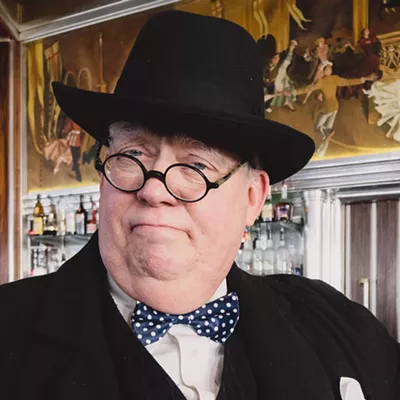The Final Exam
UA Master of Fine Arts Thesis ExhibitionOn display through Sunday, May 18
UA Museum of Art
Speedway Boulevard and Olive Avenue
Joseph Gross Gallery
Southeast corner of Park Avenue and Speedway Boulevard
621-7567
We are still in the midst of an art revolution. Whereas cubism and the abstract art that stemmed from it once changed the art landscape, technology and new media are redefining art and the artist today.
"It doesn't seem to be technology for technology's sake," Martina Shenal says. "(Technology) really does add to the piece."
Shenal is referring to the pieces on display at the Master of Fine Arts Thesis Exhibition held at the UA Museum of Art and the Joseph Gross Gallery.
As the assistant director of the UA School of Art, Shenal has coordinated past MFA exhibitions, and she is doing it again this year. But with the eight out of 14 students using new technology for their work this year, Shenal was more apprehensive than in previous years about the interaction between the art and the viewer.
"It takes more time to get something out of technology pieces," Shenal says. However, the reaction has been positive so far. At the April 17 opening reception, Shenal says viewers "were a really interested, patient audience and sat through longer pieces. I was amazed."
Also on display are works in more traditional media that showcase the refinery and self-editing that students have learned during their three years in the MFA program.
The exhibits are free and open to the public. For the UA Museum of Art's hours of operation, go to the art museum's Web site and the Joseph Gross Gallery site. --M.K.
Temporary Art
Third Annual Tucson Madonnari International Chalk Art Festival11 a.m. to 6 p.m., Saturday, April 26
Joel D. Valdez Main Library
101 N. Stone Ave.
903-4175; tucsonmadonnari.com
Artworks are often measured by their ability to endure through the ages, but a handful of local visual artists have cast this notion aside to render chalk murals on the smooth bricks of the Main Library's plaza. The murals usually last about two to three months before the weather washes them away.
"The fact that it is an ephemeral art form reinforces the community component. ... It's a one-time shot for artists to articulate a design, and for apprentices to develop skills, and for the public to be a part of the process," says Leia Maahs, artistic director of the festival. "It's not just the art--it's the experience."
Patsy Gelb, a featured artist, says she is intrigued by the idea of temporary public art. "I feel like it's more special because it's not going to be there forever." She likes the idea of creating art you don't have to set aside an afternoon at a gallery for--something that can be enjoyed during an everyday downtown visit.
Like several of the featured artists, Gelb, 20, started out apprenticing for the Madonnari International Chalk Art Festival, but for the last two years, she's had apprentices of her own. Apprentices are local high school students who show an interest in visual art, says production director Barbara Zelano. She adds that the apprenticeship program lends sustainability to the festival and to the local arts scene.
The artists and apprentices will be onsite throughout the afternoon to speak with the public as they render their murals. Musicians, dancers, high school poets and others will perform. Check the Web site for more information; the event is free. --A.M.
Poems for the Audience
Ocotillo Poetry SlamTeam Tucson Slam-Off
7 p.m., Saturday, April 26
Bentley's House of Coffee and Tea
1730 E. Speedway Blvd.
795-0338
Of the five teams Arizona will send to Wisconsin for the National Poetry Slam, only one is coming out of Tucson--and that team will consist of the top four poets from the upcoming Ocotillo Poetry Slam.
"Because of the higher stakes, people will bring out their best," says Lindsay Miller, slam master of the Ocotillo Poetry Slam, an organization she helped create three years ago.
Twelve local poets will each recite three original, memorized pieces that night. Audience judging will determine the top four overall scores, a break from the typical elimination-style slam.
Without the usual format, strategy takes on a greater role.
"If you watch someone go out, and let's say they do a political poem, and it fails with the audience, you can be sure not to pull out anything political," Miller says. "You can gauge the audience."
But the consistent strategy is to have a wide repertoire available, she says, explaining that a capacity to use a variety of poems and varied means of recitation allow the poet more flexibility and--hopefully--a potential for higher scores.
There is no cost at the door, but a suggested donation of $5 will go toward sending the team to the National Poetry Slam and bringing feature poets in to Tucson.
"It's nice to get voices from out of town," Miller says.
On Saturday night, the audience will have the chance to send the voices out. --M.K.
A Failing Prison System
Author Silja Talvi SpeaksNoon, Friday, April 25
Ua Women's Studies Building
1443 E. First St.
7 P.M., Friday, April 25
Friends Meeting House
931 N. Fifth Ave.
623-9141; womenbehindbars.org
One in every 99 Americans is currently incarcerated. This figure crosses genders, but women have seen the most dramatic change in incarceration rates: a 20-fold increase since 1977.
Silja Talvi, an award-winning journalist and author of Women Behind Bars: The Crisis of Women in the U.S. Prison System, says the numbers don't reflect an increase in criminal behavior. "Women have always been doing these things--drug use, drug abuse, petty stuff, heavy stuff--but our laws have changed." Increased prison sentences have taken the place of probation and county-jail sentences, and nonviolent offenses account for 50 percent of all prisoners in for parole violations.
During a visit to Perryville, an all-female prison complex in Phoenix, Talvi says, she was denied access to the "supermax" units, isolation cells where prisoners are kept alone in 23-hour lockdown. "What I want to know is what is happening to the women in there," she says, calling supermax units "cruel and unusual punishment." Talvi says that prisons like Perryville, which was converted into a female prison in 2000, are not built with women's needs in mind. "When I went to Perryville, 80 percent (of prisoners) were mothers," she says, adding that after 15 months of incarceration, a woman automatically loses custody of her child/children--her most important tie to the community upon release. She also lists other gender-specific difficulties, like going to the bathroom around male guards, uniforms made for men and menstrual issues, not to mention sexual assault.
"We understand very little about what happens behind the gates," she says, "and with female prisoners, it's even less."
Both lectures are free. --A.M.







